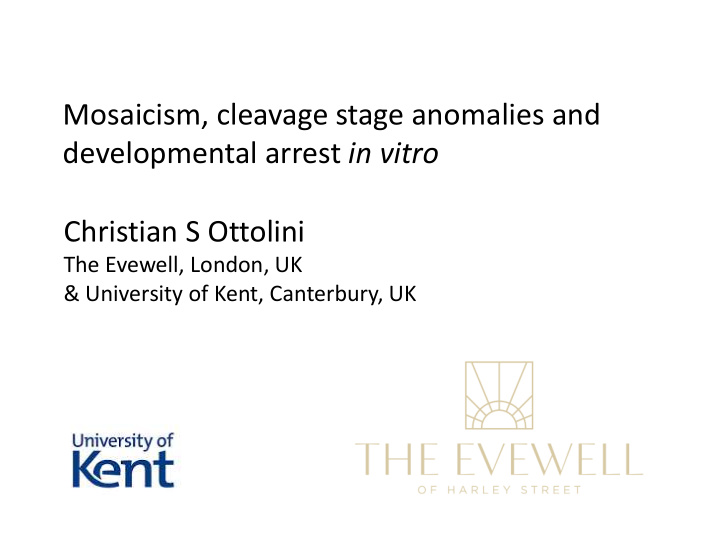



Mosaicism, cleavage stage anomalies and developmental arrest in vitro Christian S Ottolini The Evewell, London, UK & University of Kent, Canterbury, UK
Human in in vit itro preim impla lantation embry ryo develo lopment and genetics Morula/Blastocyst 50% 50% Cleavage stage arrest development Meiotic aneuploidy
Methodology • Clinical PGT cases • Serial PB1 and PB2 biopsy • Time-lapse monitoring • Blastocyst culture (Single step) • Trophectoderm biopsy and embryo vitrification • Total or partial disaggregation of arrested embryos into single cells (Day 5 or Day 6 of embryo development) • Sample and patient’s gDNA genome wide SNP genotyping
Chromosome Profilin ing Meiomapping Karyomapping Ottolini et al (2015) Nature Genetics • Accurately establish a baseline of maternal meiotic aneuploidy • Chromosome fingerprinting with unique pattern of paternal haplotypes • Single cell chromosome fingerprints consistent between cells and with Meiomap
Profile of dis isagg ggregated embry ryo
Partitioning chromosomes on a tripolar spindle • Random attachment of chromosomes to one of three axes • Normal bi-parental diplody • Maternal and paternal monosomy • Nullisomy
Profile of dis isagg ggregated embry ryo
Time-lapse – Cleavage patterns
Single cell results
Abnormal cleavage: Chromosome loss in daughter cells Tri-polar mitosis Other abnormal mitotic events • Daughter cells Biology is seldom conforms • Several other patterns of abnormal cleavage Sub-diploid (nullisomy) • Cells with no nullisomy would presumably behave Near-diploid (no nullisomy) like meiotic aneuploidy • Abnormal divisions can still give rise to normal Diploid cells
Findings & Clinical implications • Most failure of human in vitro fertilisation (IVF) has an underlying genetic basis. • Catastrophic genomic events in early cleavage result in intercellular partitioning of the chromosomes (genome loss). • Affected (sub-diploid) cells can continue to divide but are unable to develop, post embryonic genome activation, and form into a blastocyst structure. • Cleavage stage embryo transfer will not overcome this problem. • Clinical PGT-A and mosaicism! • Understanding the issue could lead to treatments that would have the potential to double current IVF success rates.
Thank you to my collaborators… @The Bridge @University of Centre Kent Professor Alan Handyside Professor Darren Griffin Mr Michael Summers @CooperGenomics Dr Tony Gordon Dr Leoni Xanthopoulou Dr John Kitchen Dr Julija Gorodeckaja and my team @ Samantha Neumann
Recommend
More recommend